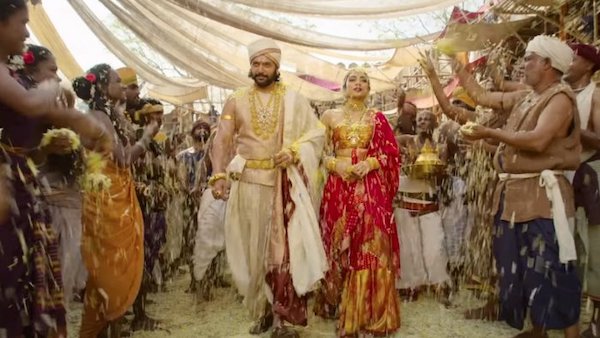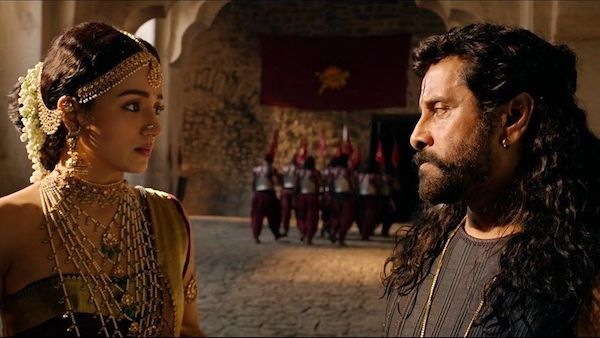Mani Ratnam’s Magnificent ‘Ponniyin Selvan I’ Elevates the Mighty Chola Empire to its Rightful Place in Indian History
- Notwithstanding the political debate concerning North Indian biases in historical narratives, and controversy surrounding the status of the Hindu religion in medieval India, the period drama casts an important light on the history of Southern India and its myriad cultures.

Maestro of Tamil cinema Mani Ratnam’s eagerly awaited period drama ‘Ponniyin Selvan I” has finally hit the theaters, not just across India where it is simultaneously dubbed in numerous Indian languages, but also in the diaspora. It was a treat to watch it in a theater in the U.S. surrounded by fellow desis, predominantly from Southern India, who greeted their favorite characters with cheers and whistles, much as they do in their homeland.
Based on Ramaswamy Krishnamurthy aka “Kalki” Krishnamurthy’s novel of the same name, chronicling the rise of the Chola dynasty, it is set in the 10th century in the historical period of Emperor Raja Raja Cholan. The Emperors of the Chola dynasty are credited with expanding the reach of the empire beyond the shores of India to distant realms such as Southeast Asia. I recall visiting Vietnam as part of the press corps that accompanied the former President of India, Dr. K.R. Naryananan and being astonished to see many statues of Hindu deities preserved in their museums. Likewise, the vast temples of Cambodia such as Angkor Wat, dating back to the 12th century, originally constructed as a temple dedicated to the deity Vishnu by King Suryavarman II.

But how did these Emperors spread their faith on these distant shores? We do not learn in much of our schools even back home in India that some of the kingdoms of Southern India such as the Cholas, were mighty maritime powers with not just armies but also navies that set sail to distant lands. Nor did we learn that the Chola fleet represented the zenith of ancient Indian sea power allowing them to go as far as Malaysia and the islands of Indonesia in their conquests. The Cholas were great builders too and have left us some of the most beautiful examples of early Dravidian temple architecture. The Chola dynasty began declining by the 13th century due to the resurgence of the Pandyas.
Kalki’s novel describes the political and social setting of that era and is based on a number of real-life incidents and characters from the Chola Dynasty, along with characters from the author’s vivid imagination. Hailed as the pioneer of Tamil contemporary literature, Kalki Krishnamurthy was a renowned poet, writer, and journalist with over 100 short stories, 5 novels and other literary works to his credit. His magnum opus ‘Ponniyin Selvan’ remains one of the most iconic pieces in Tamil literature. This novel was published in a serialized format in the Tamil magazine named Kalki. The serial went on for over five years from 29th October 1950 to 16th May 1954. Its enduring popularity is due as much to the author’s ability to recreate characters from a bygone era as it is to the continuing relevance in India of political dramas with Machiavellian intrigues as factions attempt to take down the governments of kingdoms.
The staging in Ratnam’s film is realistic, without the bombast and melodrama of more recent films like “RRR” or Rajamouli’s “Baahubali.” The songs too are more realistic, focusing on village life, rather than on the charisma of the main actors.
The staging in Ratnam’s film is realistic, without the bombast and melodrama of more recent films like “RRR” or Rajamouli’s “Baahubali.” The songs too are more realistic, focusing on village life, rather than on the charisma of the main actors. So, it is interesting to see that the film has already drawn crowds in less than a month since its release on September 30th. Unlike the directors of those box office hits, Mani Ratnam does not need to rely on stunning visual effects to ensnare the crowds. Instead, he throws his net to capture the attention of both the cognoscenti, well versed in the original epic novel, as well as the masses, people with little awareness of history or literature, let alone that of remote Southern Indian kingdoms. The main music score is the creation of maestro A.R. Rahman, adding to the grandeur of the setting.
The film has a mega star cast, including Vikram, Aishwarya Rai Bachchan, Prakash Raj, Trisha Krishnan, Jayam Rav, Karthi, Sobhita Dhulipala and Aishwarya Lekshmi. It also marks Aishwarya Rai Bachchan’s comeback to the big screen in a dual role, both as the scheming Mata Hari-like character Nandini and as a mysterious older woman who appears at critical moments to save the Chola prince. The main characters, the ailing Emperor Sundar Chola (Prakash Raj) and his three offspring, Crown Prince Aditha Karikalan (Chiyaan Vikram), his younger brother Arulmozhi Varman (Jayam Ravi) and sister Kundhavai (Trisha Krishnan), are all painted in realistic shades, without the bombast and melodrama I had half expected, after the recent historical dramas I had viewed.
I would go so far as to say there are no real heroes or heroines in the film as all the characters are depicted with both heroic and terrible qualities, much as in the Iliad or the Mahabharata. The crown prince himself is represented as a man whose unrequited passion has turned him into a violent warrior who buries his grief over his lost love by throwing himself into waging endless battles. His younger brother, the reluctant prince Arulmozhi Varman would go on to become the famous Chola emperor Rajaraja Chola I. (947 CE – 1014 CE). The only character who is depicted in a more playful light is the spy Vanthiyathevan (Karthi Sivakumar) who is described by the producers as “The Prince without a kingdom, the spy, the swashbuckling adventurer.” Needless to say, he was my favorite, with his hilarious antics and lighthearted banter reminiscent of the young D’Artagnan of Alexandre Dumas père.
The main theme of the film is one of mystery, as the Chola empire even as it has attained great military successes, is in grave danger as a group of powerful chieftains are involved in a conspiracy to take down the aged Emperor and place his nephew Madurantaka (Rahman) on the Chola throne. At the center of the conspiracy are the scheming finance minister Periya Pazhuvettaraiyar (Sharath Kumar) and his wife, the aforesaid Lady Nandini who in particular holds a personal grudge against her former lover, Crown Prince Aditha Karikalan.
The Women of the Epic
Interestingly, both in the novel and the film, women are not mere love interests playing second fiddle to the male protagonists. Let me start with the depiction of Lady Nandini, the self-willed femme fatale who uses her beauty to ensnare the minds of the men who encounter her. In mainstream Indian films, such duplicitous women are usually either killed or tamed by the hero in the end, as per the Manusmriti-inspired depiction of women as temptresses who need to be constantly kept under control by the men in their lives. Lady Nandini, on the contrary, incites a scandal by marrying the sexagenarian Chancellor Treasurer Periya Pazhuvettaraiyar even as she continues to harbor a passion for the crown prince Aditha Karikalan.

Next, we have Princess Kundavi of the Chola kingdom. Her father, the aged Emperor is bedridden while her two brothers are preoccupied with their personal lives. Hence the intrepid princess takes up the responsibility of navigating the kingdom through dangerous times. She is perceived by the citizens of her kingdom as a benefactor who uses her wealth to build hospitals and care for the poor all over the kingdom.
But it is not only aristocratic women who play a key role in the saga. The lissome boatwoman Poonguzhali is the epitome of a fiercely independent woman braving the high tides of the mighty ocean as she rows her craft to Lanka and back. She is depicted as a feisty woman who is not bound by the rules of the mortal world. Finally, the elusive deaf and mute Mandakini Devi is the aunt of Poonguzhali and lives on her own, far from civilization.
The film has also created a huge debate in social media over the North-South tensions, with many from the South and particularly the state of Tamil Nadu castigating their compatriots from the North for little awareness of the might and range of the Chola kingdom which had stretched across present-day Tamil Nadu, Kerala, as well as parts of Andhra Pradesh and Karnataka. It has even ignited a furor between the Shaivites and the Vaishnavites with cultural theorists contending that, back in the era of the Cholas, they did not use the term “Hindu” to denote a common religious identity but considered themselves to belong to very different faiths.
Regional political parties, too, have leaped into the fracas to claim that the Chola rulers were devotees of Shiva and did not see themselves as Hindu, as that term came much later, an issue that has been vigorously contested by the central government which attempts to represent all these factions under the broader umbrella of Sanatana Dharma. Factions from both the left and the right of the political spectrum have accused the director of supporting specific agendas. Mani Ratnam is not only facing an ideological battle here but also a legal one as a petition has even been filed in the Madras High Court challenging his depiction of the Chola empire.
Observing all these debates with keen interest, I recalled my own school days where indeed the focus was far more on the mighty kingdoms of Northern India, the Guptas, the Mauryas, the Mughals and the British, with some attention given to Vikramaditya, among others. But the mighty Southern Kingdoms of the Cholas, the Cheras and the Pandyas did not receive as much attention by any means. But India is a huge country and the education system is vastly different from state to state, and schools like the Kendriya Vidyalaya and others that follow the NCERT syllabus tend to cover more ground than in the regional schools. The film will no doubt play an important role in getting more attention paid to the history of Southern India and its myriad cultures, and that can only be applauded once the dust settles. Be that as it may, the Cholas have arrived in the pan- Indian psyche.
Dr. Shoba Sharad Rajgopal is a Professor of International Feminist Studies at Westfield State University in Massachusetts, where she teaches in the Department of Ethnic & Gender Studies. Her doctorate is in Media Studies from the University of Colorado, Boulder. Before she arrived in the United States, she worked as a News Correspondent for the Indian TV networks based in Mumbai, India, and has also done in-depth news reports for CNN International. Her journalistic work focused on the struggles of women and indigenous people in postcolonial nation-states. Her work has been published widely, in academic journals as well as in newspapers and feminist magazines such as Ms. in the U.S.


